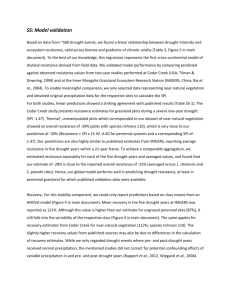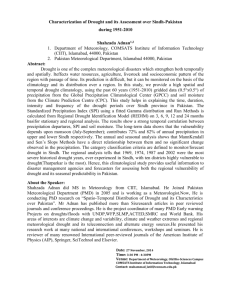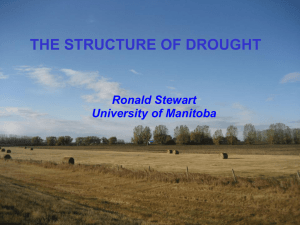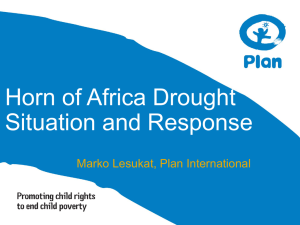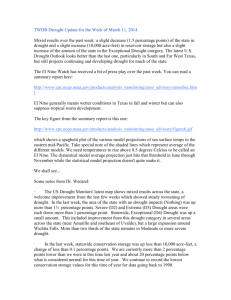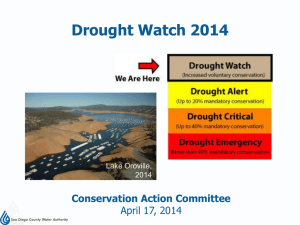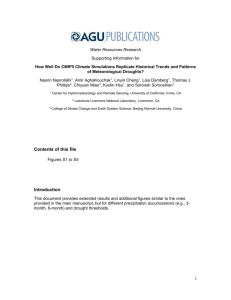Interim Project Report group 3
advertisement
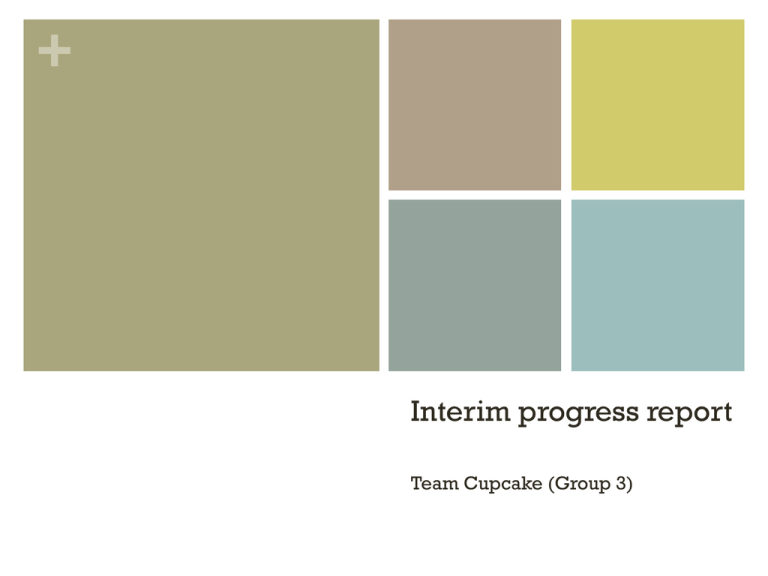
+ Interim progress report Team Cupcake (Group 3) + Our Asks Final product? Conceptual model (process map) Key takeaways What have we missed, what could be cut? + Objective Put forth an interregional assessment of the preparedness and resilience of Mediterranean nations across intergovernmental and interpolitical relationships during a period of extreme drought + History of climate change and interstate conflict Bellagio Conference on Climate Change, Food Production, and Interstate Conflict 1975 UN Millennium Summit Climate change and its possible security implications 2009 + Vulnerability & Readiness We’re interested in how this varies across the Mediterranean ● EU, Non EU, Asia and Africa There are already assessments of the vulnerability and readiness at national scales ● e.g. NDGain Index There are two particular factors we’re focusing on: ● “Adaptive capacity of the communities is often depleted when they are in conflict zones” (UNEP, 2009) ● Membership of political unions (e.g. EU) ND-GAIN Index of Vulnerability and Readiness + Governance United Nations Comprehensive, guidance on climate change, resource management, and displaced peoples European Union Comprehensive, guidance on climate change, resource management, and displaced peoples Middle East League of Arab States (?) African Union Research, advocacy and capacity-building for climate change resilience Non – EU Europe Mediterranean Union “peace, stability and prosperity” Individual States IPCC, 2013: Annex I: Atlas of Global and Regional Climate Projections Supplementary Material RCP8.5 IPCC, 2013: Annex I: Atlas of Global and Regional Climate Projections Supplementary Material RCP8.5 IPCC, 2013: Annex I: Atlas of Global and Regional Climate Projections Supplementary Material RCP8.5 IPCC, 2013: Annex I: Atlas of Global and Regional Climate Projections Supplementary Material RCP8.5 Economic Impact: No Drought 3.0% Economic losses for RCP 8.5 warming Africa Middle East + Need for finer scale/sector estimates 2.0% 1.5% 1.0% Europe % GDP 2.5% RICE 2010 Global temperature increase Best estimate 2.0 C Likely range 1.4 C - 2.6 C How these estimates would change if a “super drought” is superimposed? Include the possibility of “poverty traps” and downward development spirals 0.5% Social and governance consequences + Drought and aridity + The Standard Precipitation Index (SPI) The Standard Precipitation Index (SPI) shows the actual precipitation compared to the probability of precipitation for various time frames. The SPI is an index based on precipitation only. It can be used on a variety of time scales, which allows it to be useful for both short-term agricultural and long-term hydrological applications. A drought event occurs any time the SPI is continuously negative and reaches an intensity of -1.0 or less. The event ends when the SPI becomes positive. Each drought event, therefore, has a duration defined by its beginning and end, and an intensity for each month that the event continues. The positive sum of the SPI for all the months within a drought event can be termed the drought’s “magnitude”. The National Drought Mitigation Center http://drought.unl.edu/ + Southern Europe North Africa Middle East European Drought Observatory http://edo.jrc.ec.europa.eu/ Climate Change and Migration: Mediterranean Basin Climate change: Exacerbate existing migration flows Different hazards, different effects: Gradual vs. extreme changes Important questions: 1) What are the existing migration connections in the Mediterranean Basin? 2) What combination of circumstances currently lead people to move there? 3) How might a severe drought exacerbate these conditions? 4) Potential for novel migration flows? Abel and Sander, 2014 + Potential Economic Impacts: Drought Two major factors in the regional economy: tourism and agriculture Influence of these sectors on GDP is not evenly spread out Agriculture influence is the highest in: Albania (19.5%) Syria (17.6%) Morocco (15.1%) Egypt (14.5%) Tourism influence is highest in: Croatia (12.1%) Montenegro (9.8%) Morocco (8.6%) Tunisia (7.3%) + Potential Economic Impacts: Drought (cont’d) Agriculture might represent bigger impacts as a larger portion of the economy in more vulnerable countries Impacts on agriculture are also easier to immediately discern than those on tourism There are human dimension uncertainties surrounding both Agriculture impact depends on land management Tourism impact depends on how those outside the region respond – there is more of a lag in response Drought can lead farmers to transition to tourism which may actually help conserve remaining water resources + Maslow’s hierarchy – lowered capacity Desertification – removes safety and physiological due to un-inhabitability, un-profitability Migration/displaced persons – removes belonging, safety, physiological due to life disruption/involuntary moves Scarcity/Economic Reduction – removes self-actualization, selfesteem, belonging, safety, physiological due to limited resources + Maslow’s hierarchy – point of intervention Current view is that climate change can be solved only after immediate needs (jobs, food, education, etc) have been solved Climate change causes problems in areas of belonging, safety, and physiological and should be solved for in conjunction with other needs + Our Asks Final product? Conceptual model (process map) Key takeaways What have we missed, what could be cut?

